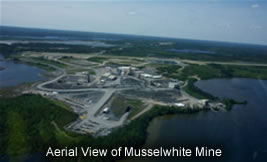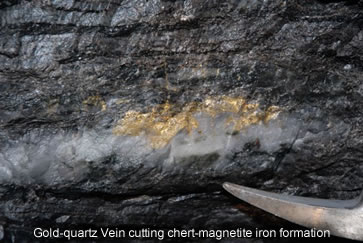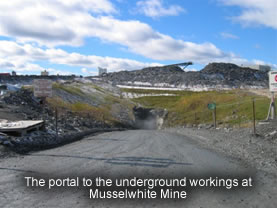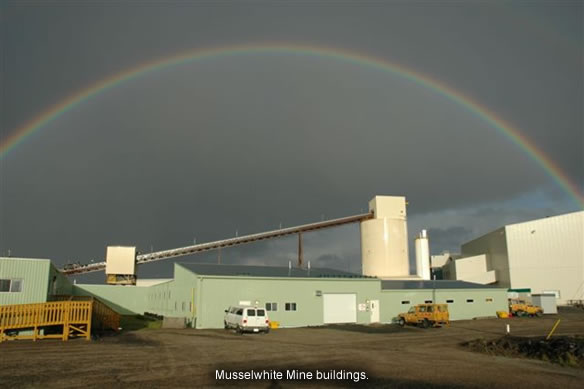The Musselwhite Mine
The Musselwhite gold mine has quietly grown into a giant deposit since it first opened in 1997. It is wholly owned by Goldcorp Canada Ltd. and is located in Northwestern Ontario, 480 km NNW of Thunder Bay. The mine currently produces ~260,000 ounces of gold per year and has produced 3.1 million ounces to date with a current mine life extending to 2019 and considerable potential for further discoveries. Access to the ore zones is via a portal and ramp system which now extends down to the 945 metre level.

Gold was first discovered in the area in 1962 by brothers Harold and Allan Musselwhite of Kenpat Mines Ltd. who found erratic gold mineralization in a quartz vein on the north side of Opapimiskan Lake and several showings in iron formation on the south side of the lake. These two determined prospectors continued to explore the area largely on their own until 1973 when a syndicate of Dome Exploration, Canadian Nickel Co., Esso Minerals Canada Ltd. and Lacana Mining Corp. stepped in to finance further work. Years of exploration drilling eventually led to the discovery of the West Anticline Zone in 1983 and the T-Antiform Zone in 1986 and outlined 1.8 million ounces of gold. The remaining partners in the syndicate at that time, Placer Dome and TVX, had faith that much more ore would be found once they were underground and proceeded with development of the Musselwhite Mine.

The mine opened in 1997 and over the following years several major ore zones were found on the lower limbs of the PQ Deeps synform adjacent to the original T-Antiform ore zones. The remaining reserves and resources (Indicated + Measured) sits at 2.3 million ounces, with a further 0.85 million ounces of inferred resources. Combined with the past production, these resources give a grand total of 6.2 million ounces, qualifying Musselwhite as "giant" deposit" and more than justifying the developer's faith in this deposit.
GEOLOGY

Musselwhite is found within the northwestern portion of the Archean age Superior geological province and lies along the edge of the North Caribou proto-continental core, at the boundary with the Island Lake Domain. The host rocks are about 2.98 billion years old and the age of the ore at Musselwhite has been determined to be 2.69 billion years. Mineralisation is currently believed to be related to an orogeny (mountain-building event) caused by the collision of the Oxford-Stull Terrane about 75 km away, much like the collision of the Indian sub-continent with Asia.

Musselwhite is somewhat unusual in that the host rocks are well within the high temperature and pressure amphibolite grade metamorphic area (formed at ~550 deg C and 9 km depth), more than 5 km from the lower temperature and pressure greenschist grade rocks. The predominant ore host is a silicate facies (variety) of a banded iron formation composed of coarse almandine garnets in fine-grained grunerite (iron-rich amphibole). During shearing the grunerite flowed in a ductile manner while the garnets proved more resistant and prone to fracturing. Mineralised shear zones within this unit are characterised by quartz flooding and veining, coarse hydrothermal garnets, green hornblende replacing the grunerite, and pyrrhotite as veins and blebs. Gold is directly proportional to the pyrrhotite content and the great majority occurs with pyrrhotite filling fractures in the garnets. Smaller ore zones are also found in the adjacent chert-magnetite oxide facies of the iron formation and rare gold-quartz veins are also found scattered throughout the overlying basaltic volcanic rocks. The majority of specimen-quality samples come from these scattered quartz veins in the volcanic rocks or secondary, remobilised veins in the chert-magnetite iron formation.




